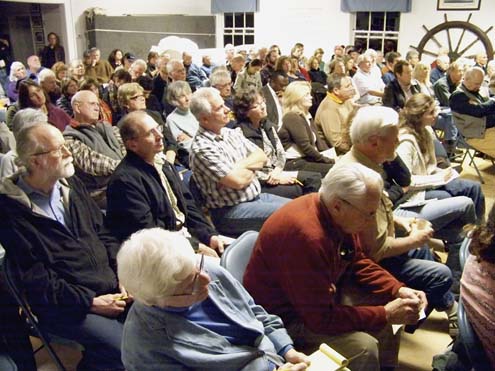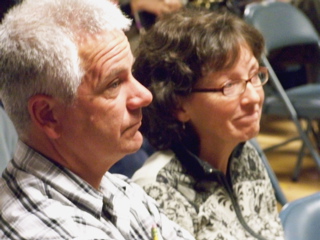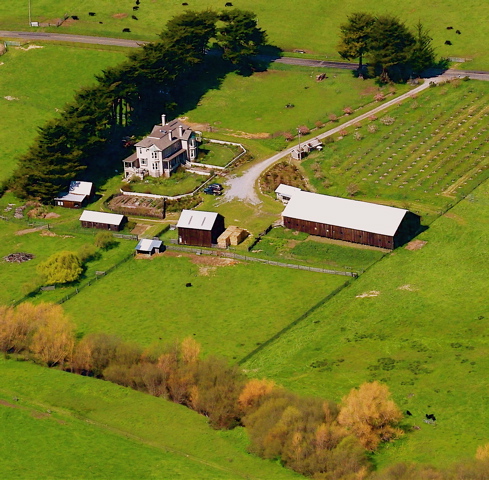Tue 31 Mar 2009
Crowd in Inverness Friday calls for reviving park’s Citizens Advisory Commission
Posted by DavidMitchell under agriculture, General News, History, Inverness, Marin County, Photography, The Point Reyes Light Newspaper, West Marin nature, Wildlife
1 Comment
Against my better judgment I showed up for Friday’s “Community Conversation” concerning the Point Reyes National Seashore’s intention to close Drakes Bay Oyster Company. Since retiring three years ago, I’ve continued to write about public issues in West Marin, but I haven’t taken part in many political events. Having achieved Nirvana, I’d rather not disturb it.

But Friday evening, I was one of 125 or so West Marin residents who filled the Inverness Yacht Club for a heavily structured discussion of the park.
Sounding like marriage counselors, a team of moderators started the meeting by telling us we were there to express our feelings, not to present facts.
To avoid bad feelings, we couldn’t criticize anybody by name (e.g. National Seashore Supt. Don Neubacher) but could only refer to his organization (e.g. “the park”). In fact, the moderators later called me out for naming names when I said President Obama is an improvement over President Bush.
The members of a “community” need to “communicate,” the moderators said more than once. No speaker should hog the microphone, they added, but were themselves slow to relinquish it. After more than half an hour of a two-hour meeting had been spent on these introductory comments with no letup in sight, I began eying the door next to me only to discover it merely went to a fire escape. On the other hand, the moderators’ efforts to ensure parlor-like decorum did pay off. I can recall more acrimony during a public discussion of museum hours.
Phyllis Faber told the group that Supt. Neubacher was away but had said that even if he were in town, he wouldn’t attend.
Faber added that Neubacher also said the park’s associate superintendent was likewise out of town but would have attended were she here. (Faber is co-founder of MALT, a fellow of the California Native Plant Society, and an author of a botanical guide, so her account is probably reliable.)

At the Drakes Bay Oyster Company site (seen here), oysters are sold and canned. A Park Service use permit, which expires in 2012, is strictly for these onshore facilities and not for oyster growing in the estero itself, which has been designated “potential wilderness.” Neubacher supporters have claimed that extending the onshore facilities’ use permit would be a threat to wilderness nationwide because of the precedent it would set. Others claim that makes neither legal nor logical sense.
Gordon Bennett, a member of the Marin Group of the San Francisco Bay Chapter of the national Sierra Club, has been carrying Neubacher’s water (not always with the support of his group) ever since the park superintendent three years ago first proposed shutting down the oyster company come 2012. On the eve of Friday’s meeting, Bennett sent an email to those sympathetic to Neubacher, warning them off by claiming the meeting was a “set-up” which had been “organized by proponents” of the oyster company.
It’s hard to tell whether the email had any effect. Some members of the Environmental Action Committee of West Marin, which supports Neubacher’s position, were on hand, including its president and a former board member. A couple of people, including forester Tom Gaman of Inverness, said the park should get rid of the oyster company to create wilderness.
Most of those who spoke, however, like most West Marin residents one hears on the street, supported the company. Several people, such as innkeeper Frank Borodic of Olema, said the oyster company is well run and good for the environment.
After two hours, however, only a couple of proposals got virtually unanimous support from the audience: 1) have additional oyster-company critics at future Community Conversations in order to create more of a dialogue; 2) get Congresswoman Lynn Woolsey to introduce legislation resurrecting the Citizens Advisory Commission to the GGNRA and Point Reyes National Seashore.
Because the two parks were established to serve the Bay Area’s mostly urban population, Congress in 1972 decided that Bay Area local governments should nominate candidates for a Citizens Advisory Commission, which would then be appointed by the US Secretary of the Interior.
Since they were appointed by a member of the president’s cabinet, the commissioners’ decisions, while only advisory, carried weight with the park administration. A superintendent could not ignore them without risking his job, former Supt. John Sansing once told me.

Supt. Neubacher and his staff have tried to discredit Drakes Bay Oyster Company by telling county and federal officials that seals are frightened away by the growing and harvesting of oysters. Apparently not having heard about this, the 18 harbor seals seen here are sunning themselves on oyster racks in neighboring Tomales Bay.
The advisory commission had needed Congressional reauthorization every few years, and for almost three decades, Congress approved it. However, in 2002, its term expired, and with Republicans in charge of Congress and the White House, the commission was allowed to die.
This time [then-Interior Secretary] Gale Norton and the Park Service said, “It’s been a very good commission for 29 years, but we don’t need it anymore,” former Commissioner Amy Meyer told me in 2007. National Seashore spokesman John Dell’Osso in 2004 had already told me the park administration did not want the commission revived because it sometimes interfered with what the Park Service felt should be done.
The Neubacher administration has also argued that local residents don’t speak for all Americans. It’s a specious argument since most park visitors are from the nine-county Bay Area and are far more familiar with the park, and with anything going wrong in it, than are people in other parts of the country, who seldom, if ever, see the National Seashore.
 Closely following Friday’s discussion are oyster company owners Kevin and Nancy Lunny.
Closely following Friday’s discussion are oyster company owners Kevin and Nancy Lunny.
Meyer noted the commission had acted as an “interface” between the public and the park, and its absence has been felt. In the past four years, there has been widespread public dissatisfaction with the National Seashore over: 1) a 2004 ranger-pepper-spray scandal; 2) the inhumane slaughter of non-indigenous deer a year ago; 3) the present oyster-company dispute. Without the advisory commission to provide the public with a forum for resolving these issues, they have become so contentious that Supt. Neubacher is seldom seen around town anymore.
Congresswoman Woolsey four years ago introduced legislation to resurrect the commission, and it was attached to a House bill (which was being pushed by now-Speaker Nancy Pelosi and others) to acquire land in San Mateo County for the GGNRA. The bill passed in 2005, but when it did, the rider resurrecting the commission was gone.
Meyer said she and other people went to Congresswomen Pelosi and Woolsey, asking that they temporarily drop the advisory-commission legislation. The fear, Meyer said, was that the Bush Administration would pack the advisory commission with people who shared his ideology.
On Friday night, I suggested that since we now have the Obama administration, the time is ripe to resurrect the commission. A number of other speakers, including Liza Crosse, aide to Marin County Supervior Steve Kinsey, agreed. And when a show of hands was taken later, almost everyone supported the idea, regardless of where they stood on the oyster-company issue.




 The “most common industries for males” working in West Marin, City-Data.com says, are: “construction, 17 percent; professional, scientific, and technical services, 10 percent; agriculture, forestry, fishing and hunting, 10 percent; educational services, 8 percent; accommodation and food services, 7 percent; health care, 5 percent; arts, entertainment, and recreation, 5 percent.”
The “most common industries for males” working in West Marin, City-Data.com says, are: “construction, 17 percent; professional, scientific, and technical services, 10 percent; agriculture, forestry, fishing and hunting, 10 percent; educational services, 8 percent; accommodation and food services, 7 percent; health care, 5 percent; arts, entertainment, and recreation, 5 percent.”




 Sally Gale and her husband Mike live in this Victorian ranch house on Chileno Valley Road. The home, which had long been in Sally’s family, was decrepit to the point of being uninhabitable before Sally and Mike restored it during the 1990s.
Sally Gale and her husband Mike live in this Victorian ranch house on Chileno Valley Road. The home, which had long been in Sally’s family, was decrepit to the point of being uninhabitable before Sally and Mike restored it during the 1990s.


 For defense, the gopher snake frequently pretends to be a rattlesnake.
For defense, the gopher snake frequently pretends to be a rattlesnake.
 Although a wine-tasting booth in the town park was doing a brisk business Sunday and the beer booth sold out its entire inventory, the William Tell bar was crowded inside and out. In front of the bar, a band played, and some folks danced.
Although a wine-tasting booth in the town park was doing a brisk business Sunday and the beer booth sold out its entire inventory, the William Tell bar was crowded inside and out. In front of the bar, a band played, and some folks danced.


 Those efforts include a back-to-nature push by park Supt. Don Neubacher to shut down an oyster farm in Drakes Estero. Gordon Bennett, who regularly represents the Sierra Club at county meetings, warned supervisors on [May 6] that unless they tell US Sen. Dianne Feinstein that they don’t oppose Neubacher’s efforts, he would urge the club to actively oppose the county’s tax plan.
Those efforts include a back-to-nature push by park Supt. Don Neubacher to shut down an oyster farm in Drakes Estero. Gordon Bennett, who regularly represents the Sierra Club at county meetings, warned supervisors on [May 6] that unless they tell US Sen. Dianne Feinstein that they don’t oppose Neubacher’s efforts, he would urge the club to actively oppose the county’s tax plan. Bennett’s threat could have been anticipated. National Seashore Supt. Neubacher admitted to federal investigators that in April 2007 he had told Kinsey that environmental groups might “go to wa,” to ensure that Drakes Estero becomes wilderness in 2012, the Inspector General’s report says.
Bennett’s threat could have been anticipated. National Seashore Supt. Neubacher admitted to federal investigators that in April 2007 he had told Kinsey that environmental groups might “go to wa,” to ensure that Drakes Estero becomes wilderness in 2012, the Inspector General’s report says. Neubacher (right) told supervisors the oyster company was disturbing harbor seals and that the Marine Mammal Commission had begun an investigation.
Neubacher (right) told supervisors the oyster company was disturbing harbor seals and that the Marine Mammal Commission had begun an investigation. Nonetheless, as investigators noted, at the supervisors’ hearing, Neubacher portrayed the Marine Mammal Commission’s interest in the issue by stating, “I mean it’s that complex, because now you’re talking about the Marine Mammal Commission, which wrote us a letter this morning. They’re going to take it up on a national level.”
Nonetheless, as investigators noted, at the supervisors’ hearing, Neubacher portrayed the Marine Mammal Commission’s interest in the issue by stating, “I mean it’s that complex, because now you’re talking about the Marine Mammal Commission, which wrote us a letter this morning. They’re going to take it up on a national level.” Well before the supervisors’ hearing, the park’s propaganda war against the oyster company was underway, with several prominent West Marin environmentalists unwittingly lending their credibility to the park’s misrepresentations of science.
Well before the supervisors’ hearing, the park’s propaganda war against the oyster company was underway, with several prominent West Marin environmentalists unwittingly lending their credibility to the park’s misrepresentations of science. In the course of filing a series of Freedom of Information Act request on harbor seal data, investigators noted, Dr. Goodman claimed “there was a ‘double standard'” in the way the National Park Service supplied information to members of the public.
In the course of filing a series of Freedom of Information Act request on harbor seal data, investigators noted, Dr. Goodman claimed “there was a ‘double standard'” in the way the National Park Service supplied information to members of the public. Although an agent of the Interior Department’s Inspector General said that Bennett and Dr. Goodman had asked for different seal data, Dr. Goodman’s repeated requests for data on seals finally forced the Park Service to admit it had none prior to 1996. Allen herself would later admit to investigators that her statement to county supervisors that the Park Service possessed 25 years of data on seals in the estero was untrue.
Although an agent of the Interior Department’s Inspector General said that Bennett and Dr. Goodman had asked for different seal data, Dr. Goodman’s repeated requests for data on seals finally forced the Park Service to admit it had none prior to 1996. Allen herself would later admit to investigators that her statement to county supervisors that the Park Service possessed 25 years of data on seals in the estero was untrue. How did some environmental groups come to be primed for an attack on the oyster company? To some degree, it would appear, this happened during one or more meetings at the park. One gathering was in January 2005, Lunny (right) told investigators. He said it included “Neubacher and local environmentalists Ken Fox, president of the Tomales Bay Association; Jerry Meral, member of the Environmental Action Committee of West Marin; and Gordon Bennett, vice chair of the Sierra Club’s Marin Group,” the Inspector General reported.
How did some environmental groups come to be primed for an attack on the oyster company? To some degree, it would appear, this happened during one or more meetings at the park. One gathering was in January 2005, Lunny (right) told investigators. He said it included “Neubacher and local environmentalists Ken Fox, president of the Tomales Bay Association; Jerry Meral, member of the Environmental Action Committee of West Marin; and Gordon Bennett, vice chair of the Sierra Club’s Marin Group,” the Inspector General reported. The inspectors did not report what was said at these meetings. They note only that Fox, like Bennett, said their discussions did not include “financially ruining the Lunnys or about trying to shut Drakes Bay Oyster Company down prior to 2012.”
The inspectors did not report what was said at these meetings. They note only that Fox, like Bennett, said their discussions did not include “financially ruining the Lunnys or about trying to shut Drakes Bay Oyster Company down prior to 2012.” The federal investigation was launched in April 2007, the Inspector General wrote, shortly after oyster company owners Kevin and Nancy Lunny wrote to us requesting an investigation into the actions of Point Reyes National Seashore Supt. Donald Neubacher. Specifically, the Lunny family alleged that Neubacher had undermined and interfered with the family’s business and had slandered the family’s name.
The federal investigation was launched in April 2007, the Inspector General wrote, shortly after oyster company owners Kevin and Nancy Lunny wrote to us requesting an investigation into the actions of Point Reyes National Seashore Supt. Donald Neubacher. Specifically, the Lunny family alleged that Neubacher had undermined and interfered with the family’s business and had slandered the family’s name. “Our investigation determined that in this report and in a newspaper article, Point Reyes National Seashore senior science advisor Sarah Allen had misrepresented research regarding sedimentation in Drakes Estero completed in the 1980s by US Geological Survey scientist Roberto Anima.
“Our investigation determined that in this report and in a newspaper article, Point Reyes National Seashore senior science advisor Sarah Allen had misrepresented research regarding sedimentation in Drakes Estero completed in the 1980s by US Geological Survey scientist Roberto Anima. And where did this “information contrary to her characterization of Anima’s findings” come from? Both a fisheries biologist with the National Park Service and an environmental scientist with the California Department of Health Care Services.
And where did this “information contrary to her characterization of Anima’s findings” come from? Both a fisheries biologist with the National Park Service and an environmental scientist with the California Department of Health Care Services. The Department of Health Services environmental scientist said he told Allen in a telephone conversation in approximately October 2006 that Anima had not tested any correlation between sediment and oyster feces in Drakes Estero.
The Department of Health Services environmental scientist said he told Allen in a telephone conversation in approximately October 2006 that Anima had not tested any correlation between sediment and oyster feces in Drakes Estero. Allen, for example, had cited the assessment in blaming oyster growing for invasive species showing up in Drakes Estero. Dr. Elliott-Fisk, however, told investigators that although any introduction of an invasive species to the estero was “bad,” researchers could not definitely attribute the invasive species to the mariculture operation.
Allen, for example, had cited the assessment in blaming oyster growing for invasive species showing up in Drakes Estero. Dr. Elliott-Fisk, however, told investigators that although any introduction of an invasive species to the estero was “bad,” researchers could not definitely attribute the invasive species to the mariculture operation. Going even further in his criticism was John Wullschleger, a fishery biologist with the National Park Service in Fort Collins, Colorado. The fisheries biologist had provided “technical oversight” for the UC Davis’ assessment of Drakes Estero, and he didn’t consider the assessment thorough enough on some matters to be cited as authoritative on key claims in Allen’s Sheltered Wilderness Report.
Going even further in his criticism was John Wullschleger, a fishery biologist with the National Park Service in Fort Collins, Colorado. The fisheries biologist had provided “technical oversight” for the UC Davis’ assessment of Drakes Estero, and he didn’t consider the assessment thorough enough on some matters to be cited as authoritative on key claims in Allen’s Sheltered Wilderness Report. National Seashore Supt. Neubacher (right) repeatedly comes off in the Inspector General’s report as deceitful, even in petty matters. For example, The Point Reyes Light on May 18, 2006, published an article that cited a UC Davis assessment of Drakes Bay in concluding that oyster farming was not harming Drakes Estero, prompting Allen to write the Sheltered Wilderness Report as a rebuttal.
National Seashore Supt. Neubacher (right) repeatedly comes off in the Inspector General’s report as deceitful, even in petty matters. For example, The Point Reyes Light on May 18, 2006, published an article that cited a UC Davis assessment of Drakes Bay in concluding that oyster farming was not harming Drakes Estero, prompting Allen to write the Sheltered Wilderness Report as a rebuttal. The article, which also quoted Kevin Lunny (left), said the assessment showed that oyster growing “has no statistically significant effects on the estuary’s water quality, fish, and eelgrass.”
The article, which also quoted Kevin Lunny (left), said the assessment showed that oyster growing “has no statistically significant effects on the estuary’s water quality, fish, and eelgrass.” Even within the regional office of the Park Service, the National Seashore administration’s politicizing research bothered staff. Investigators reported, “A scientist for the Pacific West Region of the National Park Service opined that in the Sheltered Wilderness report, Allen and ‘probably her colleagues’ had drawn conclusions that simply cannot be sustained,” particularly since there was something a little bit sketchy about the [underlying Drakes Estero Assessment], “which ‘itself is overreaching.'”
Even within the regional office of the Park Service, the National Seashore administration’s politicizing research bothered staff. Investigators reported, “A scientist for the Pacific West Region of the National Park Service opined that in the Sheltered Wilderness report, Allen and ‘probably her colleagues’ had drawn conclusions that simply cannot be sustained,” particularly since there was something a little bit sketchy about the [underlying Drakes Estero Assessment], “which ‘itself is overreaching.'” After reading those articles, Anima told Allen that his report did not state that he had “collected sediment cores from the estero,” as she had claimed, investigators said. Nor had he “identified pseudo feces of oysters as the primary source for sediment fill.”
After reading those articles, Anima told Allen that his report did not state that he had “collected sediment cores from the estero,” as she had claimed, investigators said. Nor had he “identified pseudo feces of oysters as the primary source for sediment fill.” Further, Anima’s statements that the effects of oyster mariculture on sediment in Drakes Estero required further study were omitted from both versions of the Sheltered Wilderness reports that were released to the public.”
Further, Anima’s statements that the effects of oyster mariculture on sediment in Drakes Estero required further study were omitted from both versions of the Sheltered Wilderness reports that were released to the public.”
 The Inspector General’s report also reveals that Neubacher shares Allen’s low opinion of The Light. A federal investigator said Neubacher had “opined” to him “that although The Point Reyes Light was not very objective, it carried a certain amount of weight in the community but not a lot.”
The Inspector General’s report also reveals that Neubacher shares Allen’s low opinion of The Light. A federal investigator said Neubacher had “opined” to him “that although The Point Reyes Light was not very objective, it carried a certain amount of weight in the community but not a lot.”
 Although both the press and the park have focused their attention on Kevin Lunny, the entire Lunny family feels under attack. In a letter to the Inspector General’s Office, an investigator noted, Lunny complained that “Neubacher was… slandering the family name.”
Although both the press and the park have focused their attention on Kevin Lunny, the entire Lunny family feels under attack. In a letter to the Inspector General’s Office, an investigator noted, Lunny complained that “Neubacher was… slandering the family name.” A symbolic depiction by Mexican muralist José Clemente Orozco (1883-1949) of official ‘Cruelty‘ toward common people.
A symbolic depiction by Mexican muralist José Clemente Orozco (1883-1949) of official ‘Cruelty‘ toward common people. The story begins in 2006. Lunny (left), who is active in Marin Organic, wanted to be able to promote the fact that as a rancher he is a good “steward of the land,” so he applied for certification from an organization called
The story begins in 2006. Lunny (left), who is active in Marin Organic, wanted to be able to promote the fact that as a rancher he is a good “steward of the land,” so he applied for certification from an organization called  Lunny also claims Neubacher told Salmon Safe’s executive director, “This is my park, and you will not certify any ranch in this park without my permission.”
Lunny also claims Neubacher told Salmon Safe’s executive director, “This is my park, and you will not certify any ranch in this park without my permission.” The park had complained about piles of plastic left over from covering fermenting silage, but Lunny pointed out that the plastic is hauled off and “recycled two or three times per year.”
The park had complained about piles of plastic left over from covering fermenting silage, but Lunny pointed out that the plastic is hauled off and “recycled two or three times per year.” And while he would not reveal his dealings with National Seashore Supt. Neubacher (above), Kent (left) on Monday noted, “This was the most politically charged Salmon Safe certification in 12 years and more than 300 site inspections.”
And while he would not reveal his dealings with National Seashore Supt. Neubacher (above), Kent (left) on Monday noted, “This was the most politically charged Salmon Safe certification in 12 years and more than 300 site inspections.”